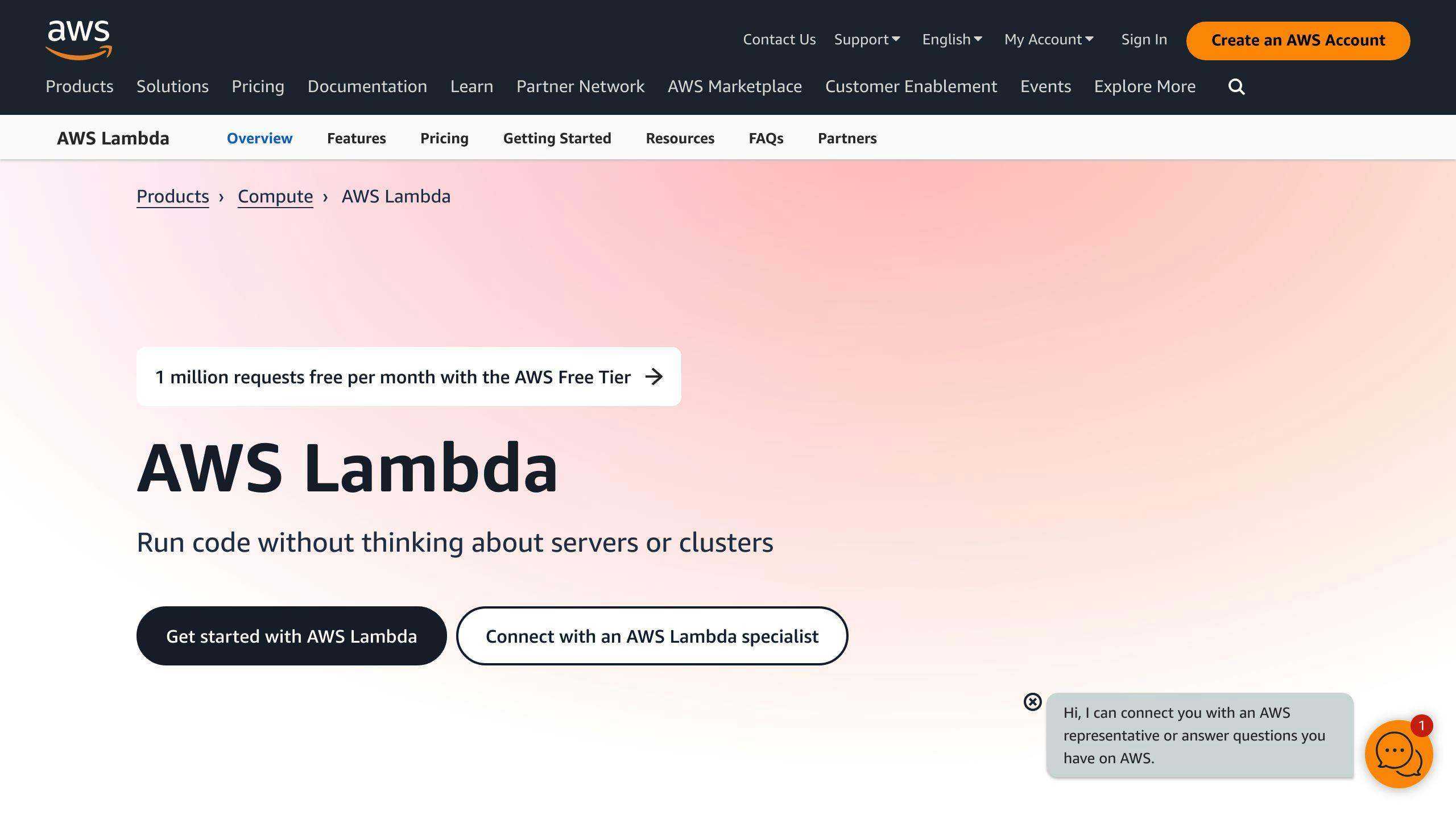AWS Lambda functions are stateless, making session management tricky. Here's how to handle it:
- Store session data externally (DynamoDB, S3, ElastiCache)
- Use stateless authentication (JWTs, Cognito)
- Let API Gateway manage sessions
Key points:
- Lambda functions forget everything after each run
- No built-in storage or shared memory
- External storage is crucial for maintaining state
- Proper session management improves user experience and security
Quick comparison of external storage options:
| Storage | Speed | Scalability | Cost |
|---|---|---|---|
| DynamoDB | Fast | High | Can be expensive |
| ElastiCache | Very fast | Medium | Requires EC2 management |
| S3 | Slower | High | Cost-effective for large data |
To implement session management in Lambda:
- Set up external storage (e.g., DynamoDB table)
- Create Lambda functions for session operations
- Use API Gateway to handle requests
- Implement proper security measures
Remember: Always encrypt sensitive data, manage IAM roles carefully, and follow AWS best practices for security and performance.
Related video from YouTube
AWS Lambda and Statelessness

How Lambda's Stateless Model Works
Lambda functions are stateless. Each run starts fresh, with no memory of past executions. Here's the gist:
- Every request triggers a new function instance
- Functions don't remember previous runs
- You must initialize data each time
- Function state vanishes after execution
This setup helps Lambda scale and handle multiple requests. But it makes managing user sessions tricky.
Effects on Session Management
Lambda's stateless nature shakes up session handling:
1. No built-in storage
Lambda can't keep session info between calls.
2. External storage needed
You'll need services like DynamoDB or Redis to maintain state.
3. More complex
It takes extra code and infrastructure to manage sessions.
4. Performance hit
Grabbing session data from external storage can slow things down.
5. Security challenges
You've got to be extra careful with session tokens.
Take an e-commerce app using Lambda. It might store shopping carts in DynamoDB. The function would fetch and update cart data with each call.
"The stateless and ephemeral nature of serverless functions shifts the way attackers approach these systems." - Hillel Solow, Serverless Security R&D
This shows why solid security is crucial, even in stateless setups.
To handle sessions in Lambda:
- Use authenticated session tokens
- Store session data externally
- Sign and encrypt tokens properly
- Use secure session management libraries
Session Management Methods for Lambda
Lambda's stateless nature makes session management tricky. Here are three ways to handle it:
External Storage for Sessions
Store session data outside Lambda for better scaling and persistence. Here's a quick comparison:
| Storage | Speed | Scalability | Cost |
|---|---|---|---|
| DynamoDB | Fast | High | Can add up |
| ElastiCache | Very fast | Medium | EC2 management needed |
| S3 | Slower | High | Cheap for big data |
Want to use DynamoDB? Here's how:
1. Make a DynamoDB table with session IDs as keys
2. Write Lambda functions to work with the table
3. Use AWS SDK in your Lambda code
Stateless Authentication
Skip server-side storage with stateless auth. JWTs and Cognito are popular:
JWT:
- Create a JWT with user info at login
- Send it to the client
- Check it on future requests
Cognito:
- Set up a User Pool
- Add Cognito auth to your Lambdas
- Use Cognito tokens for user ID and access
API Gateway for Sessions

Let API Gateway handle session cookies:
- Set up API Gateway for cookies
- Make Lambdas for auth and sessions
- Use Lambda Proxy to pass data
Here's a simple Lambda to check sessions:
def lambda_handler(event, context):
cookies = event['headers'].get('Cookie', '')
session_id = extract_session_id(cookies)
if validate_session(session_id):
return {
'statusCode': 200,
'body': 'Valid session'
}
else:
return {
'statusCode': 401,
'body': 'Invalid session'
}
This checks for a valid session cookie and responds accordingly.
Setting Up Session Management in Lambda
Let's set up session management in AWS Lambda using DynamoDB, Lambda functions, and API Gateway. Here's how:
DynamoDB for Session Storage

Create a DynamoDB table for sessions:
aws dynamodb create-table \
--table-name UserSessions \
--attribute-definitions AttributeName=sessionId,AttributeType=S \
--key-schema AttributeName=sessionId,KeyType=HASH \
--billing-mode PAY_PER_REQUEST
aws dynamodb update-time-to-live \
--table-name UserSessions \
--time-to-live-specification "Enabled=true, AttributeName=ttl"
Lambda Functions for Sessions
Here's a Python example for creating a session:
import boto3
import hashlib
import time
import json
dynamodb = boto3.resource('dynamodb')
table = dynamodb.Table('UserSessions')
def create_session(event, context):
user_id = event['userId']
session_id = hashlib.sha256(f"{user_id}{time.time()}".encode()).hexdigest()
item = {
'sessionId': session_id,
'userId': user_id,
'ttl': int(time.time()) + 3600 # 1 hour expiration
}
table.put_item(Item=item)
return {
'statusCode': 200,
'body': json.dumps({'sessionId': session_id})
}
For session validation:
def validate_session(event, context):
session_id = event['sessionId']
response = table.get_item(Key={'sessionId': session_id})
if 'Item' in response:
return {
'statusCode': 200,
'body': json.dumps({'valid': True, 'userId': response['Item']['userId']})
}
else:
return {
'statusCode': 401,
'body': json.dumps({'valid': False})
}
Connecting with API Gateway
- Create a new API in API Gateway
- Add resources for
/create-session,/validate-session, and/deactivate-session - Set up POST methods for each resource, linking them to the Lambda functions
- Deploy your API
To secure your endpoints, use a Lambda authorizer:
def lambda_handler(event, context):
auth_token = event['authorizationToken']
if auth_token == 'allow':
return generate_policy('user', 'Allow', event['methodArn'])
else:
return generate_policy('user', 'Deny', event['methodArn'])
def generate_policy(principal_id, effect, resource):
return {
'principalId': principal_id,
'policyDocument': {
'Version': '2012-10-17',
'Statement': [
{
'Action': 'execute-api:Invoke',
'Effect': effect,
'Resource': resource
}
]
}
}
That's it! You've now set up a basic session management system using AWS Lambda, DynamoDB, and API Gateway. Don't forget to handle errors, implement logging, and follow AWS best practices for security and performance.
sbb-itb-6210c22
Best Practices for Lambda Sessions
Here's how to make your Lambda sessions work better:
Securing Session Data
Protect your session info:
- Encrypt sensitive details
- Manage IAM roles carefully
- Follow AWS shared responsibility model
Example: Encrypt session data before DynamoDB storage:
from cryptography.fernet import Fernet
key = Fernet.generate_key()
f = Fernet(key)
encrypted_data = f.encrypt(session_data.encode())
Handling Errors and Logging
Track issues and control sessions:
- Use AWS CloudWatch for monitoring
- Set up alerts for quick fixes
- Log essential info to cut costs
Log errors in your Lambda function:
import logging
logger = logging.getLogger()
logger.setLevel(logging.ERROR)
def lambda_handler(event, context):
try:
# Your code here
except Exception as e:
logger.error(f"An error occurred: {str(e)}")
raise
Improving Performance
Speed up Lambda functions:
- Initialize SDK clients outside the handler
- Use environment variables for parameters
- Cache often-accessed data
| Technique | Description | Impact |
|---|---|---|
| Execution Environment Reuse | Initialize outside handler | Faster run time |
| Environment Variables | Store parameters | Easy scaling |
| Caching | Store frequent data | Fewer DB queries |
Use execution environment reuse:
import boto3
# Initialize outside the handler
dynamodb = boto3.resource('dynamodb')
table = dynamodb.Table('UserSessions')
def lambda_handler(event, context):
# Use 'table' here
Fixing Common Session Problems
Reducing Cold Starts and Delays
Cold starts in AWS Lambda can slow down your app. Here's how to fix them:
1. Use Provisioned Concurrency
This keeps Lambda functions warm. James Beswick from AWS found it can cut cold start times from 650 ms to 7-66 ms.
2. Optimize Function Size
Smaller functions load faster. Cut the fat from your code.
3. Choose the Right Language
Python, Node.js, and Go start up quicker than Java or .NET. Python is at least 2x faster than Java for cold starts.
4. Avoid VPCs When Possible
Lambda functions outside VPCs start up faster. Nathan Mashilev saw much lower latency for these functions.
| Technique | Cold Start Time Impact |
|---|---|
| Provisioned Concurrency | 7-66 ms (vs 650 ms) |
| Running Outside VPC | Up to 8.83 seconds faster |
| Using Python | At least 2x faster than Java |
Managing Session Timeouts
Lambda functions max out at 15 minutes. Here's how to handle that:
1. Use Context Object
Check remaining time with context.get_remaining_time_in_millis().
2. Set Up Signal Handlers
Create a plan B for near-timeout situations:
import signal
def timeout_handler(_signal, _frame):
logger.info("Time's up! Saving progress...")
# Save progress here
signal.signal(signal.SIGALRM, timeout_handler)
def lambda_handler(event, context):
signal.alarm(int(context.get_remaining_time_in_millis() / 1000) - 15)
# Main function code
3. Implement Idempotency
Make sure retries are safe and don't cause side effects.
4. Use Event-Driven Approach
Send failed events to an SQS queue for automatic retries.
Solving Concurrency Issues
Concurrency problems can mess up your sessions. Here's the fix:
1. Set Concurrency Limits
Stop one function from hogging everything. The default is 1000 per AWS Region.
2. Monitor and Adjust
Use CloudWatch to track function behavior and tweak limits as needed.
3. Use as Emergency Switch
Setting concurrency to zero can temporarily disable a function. Handy for testing or emergencies.
4. Know Your Account Limits
Each AWS account has a fixed AccountLimit. Know yours and ask for more if needed.
Conclusion
AWS Lambda's stateless nature makes session management tricky. Here's how to tackle it:
- Store session data in DynamoDB or S3
- Use stateless authentication
- Let API Gateway handle sessions
The session-lambda Python package makes DynamoDB sessions easy:
@session(key_name='session-id', update=False, ttl=15*60)
def lambda_handler(event, context):
session_data = get_session_data()
# Your code here
To manage Lambda sessions effectively:
- Set TTL on DynamoDB tables
- Use environment variables
- Write idempotent code
- Watch function concurrency
What's Next for Serverless Sessions?
Serverless is moving towards stateful functions. Take PartyKit, for example. It lets developers create stateful serverless functions for things like multiplayer games.
| Now | Future |
|---|---|
| External storage | Built-in state management |
| Complex sessions | Simpler coding |
| Limited real-time | Better real-time collaboration |
We'll likely see:
- More platforms with built-in state management
- Better tools for real-time, collaborative apps
- Faster cold starts and better performance
The future's bright, but today's best practices are still key for solid, scalable serverless apps with good session management.
FAQs
Can AWS Lambda maintain state?
Nope, AWS Lambda functions are stateless. They don't keep data between runs. This means:
- Each function starts fresh
- No built-in data storage across runs
- In-memory data doesn't stick around
Want to keep data between Lambda runs? You'll need external storage:
| Storage | When to use |
|---|---|
| DynamoDB | Quick NoSQL database |
| ElastiCache | Fast in-memory data store |
| S3 | Big dataset storage |
Are Lambda functions stateful?
Not by default. But you can add some statefulness:
1. Use external databases
Store session data in DynamoDB or ElastiCache.
2. Try tumbling windows
AWS feature for maintaining state in stream processing.
3. Use global variables
Store data in function-level variables, but watch out:
- Data only lasts during the function's "warm" period
- No guarantees on container warmth duration
Remember: For reliable state management, always go for external storage.


